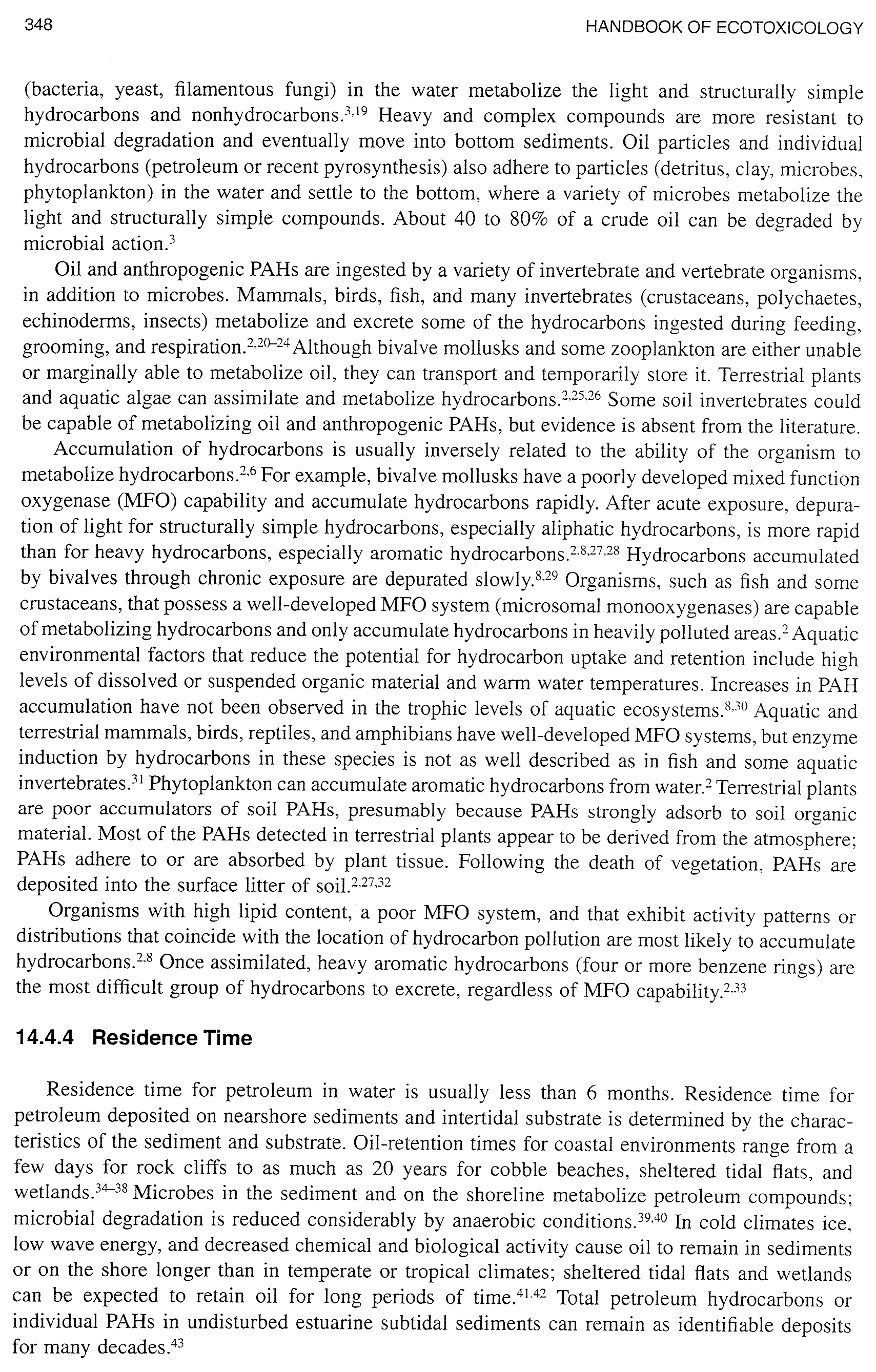24139 scan0019 (6)

348
HANDBOOK OF ECOTOXICOLOGY
(bacterła, yeast, filamentous fungi) in the water metabolize the light and structurally simple hydrocarbons and nonhydrocarbons.3,19 Heavy and complex compounds are morę resistant to microbial degradation and eventually move into bottom sediments. Oil particles and individual hydrocarbons (petroleum or recent pyrosynthesis) also adhere to particles (detritus, clay, microbes, phytoplankton) in the water and settle to the bottom, where a variety of microbes metabolize the light and structurally simple compounds. About 40 to 80% of a crude oil can be degraded by microbial action.3
Oil and anthropogenic PAHs are ingested by a variety of invertebrate and vertebrate organisms, in addition to microbes. Mammals, birds, fish, and many invertebrates (crustaceans, polychaetes, echinoderms, insects) metabolize and excrete some of the hydrocarbons ingested during feeding, grooming, and respiration.2,20-24 Although bivalve mollusks and some zooplankton are either unable or marginally able to metabolize oil, they can transport and temporarily storę it. Terrestrial plants and aąuatic algae can assimilate and metabolize hydrocarbons.2,25,26 Some soil invertebrates could be capable of metabolizing oil and anthropogenic PAHs, but evidence is absent from the literaturę.
Accumulation of hydrocarbons is usually inversely related to the ability of the organism to metabolize hydrocarbons.2,6 For example, bivalve mollusks have a poorly developed mixed function oxygenase (MFO) capability and accumulate hydrocarbons rapidly. After acute exposure, depura-tion of light for structurally simple hydrocarbons, especially aliphatic hydrocarbons, is morę rapid than for heavy hydrocarbons, especially aromatic hydrocarbons.2,8,27,28 Hydrocarbons accumulated by bivalves through chronic exposure are depurated slowly.8,29 Organisms, such as fish and some crustaceans, that possess a welI-developed MFO system (microsomal monooxygenases) are capable of metabolizing hydrocarbons and only accumulate hydrocarbons in heavily polluted areas.2 Aąuatic environmental factors that reduce the potential for hydrocarbon uptake and retention include high levels of dissolved or suspended organie materiał and warm water temperatures. Increases in PAH accumulation have not been observed in the trophic levels of aąuatic ecosystems.8,30 Aąuatic and terrestrial mammals, birds, reptiles, and amphibians have well-developed MFO Systems, but enzyme induction by hydrocarbons in these species is not as well described as in fish and some aąuatic invertebrates.31 Phytoplankton can accumulate aromatic hydrocarbons from water.2 Terrestrial plants are poor accumulators of soil PAHs, presumably because PAHs strongly adsorb to soil organie materiał. Most of the PAHs detected in terrestrial plants appear to be derived from the atmosphere; PAHs adhere to or are absorbed by plant tissue. Following the death of vegetation, PAHs are deposited into the surface litter of soil.2,27,32
Organisms with high lipid content, a poor MFO system, and that exhibit activity pattems or distributions that coincide with the location of hydrocarbon pollution are most likely to accumulate hydrocarbons.2,8 Once assimilated, heavy aromatic hydrocarbons (four or morę benzene rings) are the most difficult group of hydrocarbons to excrete, regardless of MFO capability.2-33
14.4.4 Residence Ti me
Residence time for petroleum in water is usually less than 6 months. Residence time for petroleum deposited on nearshore sediments and intertidal substrate is determined by the charac-teristics of the sediment and substrate. Oil-retention times for Coastal environments rangę from a few days for rock cliffs to as much as 20 years for cobble beaches, sheltered tidal flats, and wetlands.34-38 Microbes in the sediment and on the shoreline metabolize petroleum compounds; microbial degradation is reduced considerably by anaerobic conditions.39,40 In cold climates ice, Iow wave energy, and decreased Chemical and biological activity cause oil to remain in sediments or on the shore longer than in temperate or tropical climates; sheltered tidal flats and wetlands can be expected to retain oil for long periods of time.41,42 Total petroleum hydrocarbons or individual PAHs in undisturbed estuarine subtidal sediments can remain as identifiable deposits for many decades.43
Wyszukiwarka
Podobne podstrony:
18599 scan0013 (9) 342 HANDBOOK OF ECOTOXICOLOGY14.1 INTRODUCTION Crude petroleum, refined petroleum
scan0021 (5) 350 HANDBOOK OF ECOTOXICOLOGY In water the toxicity cif individual PAHs to plants and a
scan0017 (7) 346 HANDBOOK OF ECOTOXICOLOGY Figurę 14.4 Sources of petroleum and PAHs in the environm
49240 scan0015 (8) 344 HANDBOOK OF ECOTOXICOLOGY Naphthalene Figurę 14.2 Examples of PAH compounds w
00268 ?a148167663d78e6679e602ee961c3b 270 Montgomery experiments are often used in the design and/o
usage in New Zealand. A less detailed overview of the NZ table of radio spectrum allocations is give
295 Dynamics of a controlled anti-aircraft missile... 6. Dziopa Z., 2008, The Mode
Topie 1, DESCRIBE THE OPERATION OF DATA NETWORKS (75 ąuestions)Section 1: Describe the purpose and f
więcej podobnych podstron